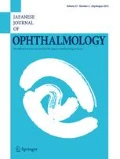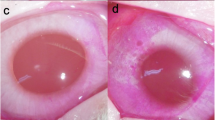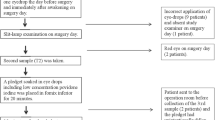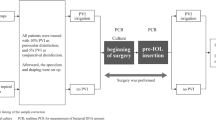Abstract
Purpose
To compare the cytotoxicity of povidone–iodine solution (PVP-I) with that of polyvinyl alcohol–iodine solution (PAI) for ophthalmic use.
Methods
Cells of the human corneal epithelial cell line HCE-T were exposed to various dilutions of PVP-I or PAI, and the cytotoxicity of these two antiseptics was evaluated. The relative toxicities of PVP-I and PAI were also investigated following the inactivation of iodine by achromatization with sodium thiosulfate.
Results
PVP-I and PAI had equivalent antiseptic effects, but the cytotoxicity of PVP-I diluted 16-fold was higher than that of PAI diluted 6-fold. Following inactivation of iodine with sodium thiosulfate, the cytotoxicity of PVP-I remained concentration dependent, whereas PAI exhibited a low toxicity that was similar to the effect of saline on cell viability. Exposure to lauromacrogol, a surfactant used in PVP-I, in solution at concentrations of 1–1000 mg/mL clearly resulted in corneal cytotoxicity. The PVP-I and PAI solutions had a pH value of 4.0 and 5.2, respectively. HCE-T cells were significantly more viable at pH 7 than at pH 1–6.
Conclusion
To avoid corneal damage, preoperative antisepsis of the surgical field should be accomplished with PAI diluted 6-fold, rather than with PVP-I diluted 16-fold. The toxicity of the iodine compound stems primarily from the available iodine concentration and partly from its pH, surfactant and osmolality. Further clinical investigations are required in order to determine the optimal concentrations for use.






Similar content being viewed by others
References
Bratzler DW, Dellinger EP, Olsen KM, Perl TM, Auwaerter PG, Bolon MK, et al. Clinical practice guidelines for antimicrobial prophylaxis in surgery. Am J Health-Syst Pharm. 2013;70:233–7.
Ciulla TA, Starr MB, Masket S. Bacterial endophthalmitis prophylaxis for cataract surgery: an evidence based update. Ophthalmology. 2002;109:13–24.
Inoue Y, Usui M, Ohashi Y, Shiota H, Yamazaki T. For the preoperative disinfection study group. Preoperative disinfection of the conjunctival sac with antibiotics and iodine compounds: a prospective randomized multicenter study. Jpn J Ophthalmol. 2008;52:151–61.
Inagaki K, Yamaguchi T, Ohde S, Deshpande GA, Kakinoki K, Ohkoshi K. Bacterial culture after three sterilization methods for cataract surgery. Jpn J Ophthalmol. 2013;57:74–9.
Ikuno Y, Sawa M, Tsujikawa M, Gomi F, Maeda N, Nishida K. Effectiveness of 1.25% povidone-iodine combined with topical levofloxacin against conjunctival flora in intravitreal injection. Jpn J Ophthalmol. 2012;56:497–501.
Nagai N, Murao T, Oe K, Ito Y, Okamoto N, Shimomura S. In vitro evaluation for corneal damages by anti-glaucoma combination eye drops using human corneal epithelial cell (HCE-T). Yakugaku Zasshi. 2011;131:985–91.
Araki-Sasaki K, Ohashi Y, Sasabe T, Hayashi K, Watanabe H, Tano Y, et al. An SV40-immortalized human corneal epithelial cell line and its characterization. Invest Ophthalmol Visual Sci. 1995;36:614–21.
Toropainen E, Ranta VP, Talvitie A, Suhonen P, Urtti A. Culture model of human corneal epithelium for prediction of ocular drug absorption. Invest Ophthalmol Visual Sci. 2001;42:2942–8.
Taliana L, Evans MD, Dimitrijevich SD, Steele JG. The influence of stromal contraction in a wound model system on corneal epithelial stratification. Invest Ophthalmol Visual Sci. 2001;42:81–9.
Ishiyama M, Miyazono Y, Sasamoto K, Ohkura Y, Ueno K. A highly water-soluble disulfonated tetrazolium salt as a chromogenic indicator for NADH as well as cell viability. Talanta. 1997;44:1299–305.
Isenberg SJ, Apt L, Campeas D. Ocular applications of povidone-iodine. Dermatology. 2002;204:92–5.
Iwasawa A, Nakamura Y. Cytotoxic effect and influence of povidone-iodine on wounds in guinea pig. Kansenshogaku zasshi. 2003;77:948–56.
Iwasawa A, Nakamura Y. Antimicrobacterial effects and cytotoxicity of povidone-iodine preparation: influence of additional surfactant. Jpn J Environ infect. 2001;16:179–83.
Gonnering R, Edelhauser HF, Van Horn DL, Durant W. The pH tolerance of rabbit and human corneal endothelium. Invest Ophthalmol Visual Sci. 1979;18:373–90.
Edelhauser HF, Hanneken AM, Pederson HJ, Van Horn DL. Osmotic tolerance of rabbit and human corneal endothelium. Arch Ophthalmol. 1981;99:1281–7.
Wille H. Assessment of possible toxic effects of polyvinylpyrrolidone-iodine upon the human eye in conjunction with cataract extraction. An endothelial specular microscope study. Acta Ophthalmol. 1982;60:955–60.
Acknowledgments
Professional editing of the English language in this article was performed by Editage (Cactus Communications).
Conflicts of interest
Y. Shibata, None; Y. Tanaka, None; T. Tomita, None; T. Taogoshi, None; Y. Kimura, None; T. Chikama, None; K. Kihira, None.
Author information
Authors and Affiliations
Corresponding author
About this article
Cite this article
Shibata, Y., Tanaka, Y., Tomita, T. et al. Evaluation of corneal damage caused by iodine preparations using human corneal epithelial cells. Jpn J Ophthalmol 58, 522–527 (2014). https://doi.org/10.1007/s10384-014-0348-y
Received:
Accepted:
Published:
Issue Date:
DOI: https://doi.org/10.1007/s10384-014-0348-y




